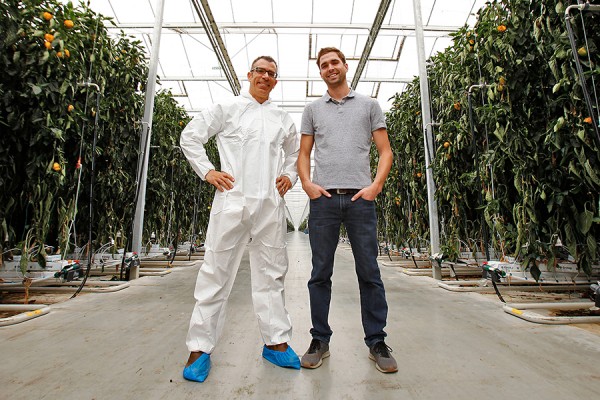 Engineering professor Rupp Carriveau and UWindsor engineering alumnus Lucas Semple, Under Sun Acres greenhouse operations engineer, are part of a national effort exploring how leading-edge greenhouse technology can be delivered to remote locations and optimized to reduce energy costs and increase production.
Engineering professor Rupp Carriveau and UWindsor engineering alumnus Lucas Semple, Under Sun Acres greenhouse operations engineer, are part of a national effort exploring how leading-edge greenhouse technology can be delivered to remote locations and optimized to reduce energy costs and increase production.
A team of University of Windsor researchers is leading a national effort on the next frontier of sustainable and accessible food.
Working with experts from government labs and industry, the multidisciplinary team is using a new growing environment modeling tool and advanced additive manufacturing — often referred to as 3D printing — to explore how leading-edge greenhouse technology can be delivered to remote locations and optimized to reduce energy costs and increase production.
“We can explore how more radical changes, like using earthen walls or solar glass, could potentially benefit a leading-edge greenhouse without ever interrupting ongoing commercial operation,” says Rupp Carriveau, the project lead and director of UWindsor’s Environmental Energy Institute.
Dr. Carriveau says the team has created energy harvesting models to design distributed, networked, power systems to provide increased and more sustainable energy for a rapidly expanding sector. Controlled environment agriculture (CEA) such as greenhouses, vertical farms, and plant factories can increase access, yield density, uniformity, and nutritional specificity of food production.
However, challenges over the availability and cost of energy for these facilities remains an obstacle.
“Our simulations will explore how new energy systems can link multiple growers to improve power sharing efficiencies and resiliency while reducing costs,” Carriveau says about the venture, dubbed the Next-Gen Amplified Sustainable Agriculture (NASA) project.
The team will also examine how advanced additive manufacturing can expand the capabilities of today’s greenhouse sector and deliver CEA to remote locations it’s never been before. Collaboration with Western University’s Institute for Earth and Space Exploration will examine how the model and maker tools in the project could be used to produce growing environments in extra-terrestrial locations.
Researchers from UWindsor, Western University; Agriculture and Agri-Food Canada; the Ontario Ministry of Agriculture, Food and Rural Affairs; Ontario Greenhouse Vegetable Growers; and Under Sun Acres have partnered on the two-year, $450,000 project supported by the Weston Seeding Innovation Fund, Mitacs, and Enbridge Inc.
Researchers will start by examining the ambient environmental conditions of the remote location and desired crop and work backwards to develop new growing systems for remote regions.
Chris Patterson, a UWindsor engineering MASc student contributing to the project, says once they determine crop needs, they will use growing climate and energy models to design and 3D print a growth system specifically optimized for that crop and remote environment.
“Advanced additive manufacturing not only significantly increases the potential for creative structural solutions to challenging building applications but can provide remote locations with the ability to reproduce parts onsite without having to wait for an airplane or rocket ship to deliver a replacement,” says project advisor and engineering professor Jill Urbanic.
The team will produce bench-scale printed growth enclosures and power systems for conditions in Kugluktuk, Canada — a remote community with extreme cold and high sun — and Hanksville, Utah, a dry desert-like setting. Printed models will be tested in Western University’s Biotron Facility, which can simulate just about any conditions on earth, Carriveau says.
An outreach program will be delivered to Essex County schools as a new 2021 STEM module. The module will be developed to enlighten and inspire young people about the important and exciting challenges ahead for the future of food production and potential food production on other planets, says Lindsay Miller, the project’s outreach coordinator.
“Sustainability of a sector really depends on evolving succession,” she adds. “Today’s young people will be feeding the future — we want to start them early.”